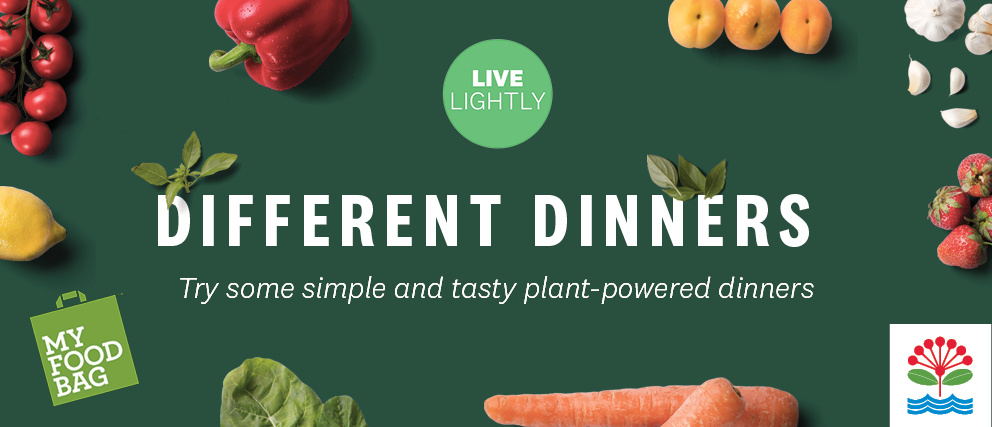
Thank you for taking part in our Different Dinners trial!
The Different Dinners trial is about enabling Tāmaki Makaurau / Auckland households to try some plant powered meals they don’t usually cook. Live Lightly did some research and found that people want easy and tasty options to help them get familiar with choosing different dinners.
We know that cooking different dinners can be a challenge, that’s why we’ve made it easy by selecting a small range of tasty, nutritious recipes created by My Food Bag. We’ll be sending you a plant-powered recipe booklet, a meal planner fridge magnet, and a handy shopping list for you to make your own shopping plan so you can try out some tasty, nutritious and easy to make different dinners.
Eating meals with more plants is not only better for your health, it’s better for the planet, too. You don’t have to switch to a complete plant-based diet to eat more sustainably. Swapping just one or two meals per week can have a big impact.
We hope you enjoy giving a few of these recipes a go, and learn some new ways to cook and eat.
For more information, visit livelightly.nz/eat, or contact us at hello@livelightly.net with any questions.
Some more information:
Why is Auckland Council conducting this research?
- As a member of C40 Cities, Auckland Council has joined many other international cities in making a commitment to take bold climate action and lead the way towards a healthier and more sustainable future [1].
- Did you know, that 71% of NZ consumption emissions are produced by households [2], with 25% of this coming from food and non-alcoholic beverages [3]? This is massive – and a key contributor to this footprint is the meat and dairy consumed in our daily diets.
- Consumption emissions factor in the full emissions associated with producing a product or service. This allows the impact of what we consume to be captured along the full life-cycle of a product including raw materials, manufacturing, distribution, waste, etc, whether it is produced in NZ or overseas. Knowing what the consumption emissions of particular products are helps people make informed choices.
- In July 2020 Auckland Council approved Te Tāruke-ā-Tāwhiri: Auckland's Climate Plan [4], with the goal to halve Auckland’s emissions by 2030 and reach net zero emissions by 2050. Food is one of the priority areas in the plan “Our goal is a low-carbon resilient local food system that provides all Aucklanders with access to fresh and healthy food”. We hope to encourage Aucklanders to adopt a flexitarian diet, which includes a larger proportion of plant-based meals but doesn’t exclude meat and dairy. This is aligned with New Zealand Dietary health guidelines [5].
What research is there to suggest Aucklanders want to change their eating choices?
- Most Aucklanders (86%) are willing to change their lifestyle to ensure we meet our climate commitments, with two in five willing to make radical change [6] (Auckland Council, Climate Change Action and Public Perceptions Survey 2019).
- 52% of Aucklanders believe we need to change our diet to protect the environment [7] (Colmar Brunton Better Futures report 2020).
- 21% of Aucklanders are already eating a meat-free diet all or most of the time [8] (Colmar Brunton Better Futures report 2020).
[1] https://www.c40.org/[2] Greenhouse gas emissions (consumption-based): Year ended 2017 | Stats NZ[3] Greenhouse gas emissions (consumption-based): Year ended 2017 | Stats NZ[4] https://www.aucklandcouncil.govt.nz/environment/Pages/auckland-climate-action-plan.aspx[5] https://www.health.govt.nz/our-work/eating-and-activity-guidelines.[6] Auckland Council, Climate Change Action and Public Perceptions Survey 2019[7] 2020 Better Futures The Auckland Story 20.03.20.pptx[8] 2020 Better Futures The Auckland Story 20.03.20.pptx